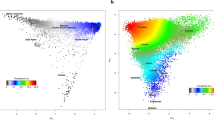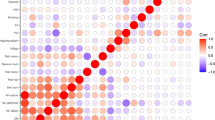Abstract
Fair color increases risk of cutaneous melanoma (CM) and basal cell carcinoma (BCC). Recent genome-wide association studies have identified variants affecting hair, eye and skin pigmentation in Europeans. Here, we assess the effect of these variants on risk of CM and BCC in European populations comprising 2,121 individuals with CM, 2,163 individuals with BCC and over 40,000 controls. A haplotype near ASIP, known to affect a similar spectrum of pigmentation traits as MC1R variants, conferred significant risk of CM (odds ratio (OR) = 1.45, P = 1.2 × 10−9) and BCC (OR = 1.35, P = 1.2 × 10−6). The variant in TYR encoding the R402Q amino acid substitution, previously shown to affect eye color and tanning response, conferred risk of CM (OR = 1.21, P = 2.8 × 10−7) and BCC (OR = 1.14, P = 6.1 × 10−4). An eye color variant in TYRP1 was associated with risk of CM (OR = 1.15, P = 4.3 × 10−4). The association of all three variants is robust with respect to adjustment for the effect of pigmentation.
This is a preview of subscription content, access via your institution
Access options
Subscribe to this journal
Receive 12 print issues and online access
$209.00 per year
only $17.42 per issue
Buy this article
- Purchase on Springer Link
- Instant access to full article PDF
Prices may be subject to local taxes which are calculated during checkout
Similar content being viewed by others
Change history
29 July 2008
In the version of this article initially published, there were two errors in the numbers reported in the abstract. The correct odds ratio for the association of the ASIP haplotype with risk of basal cell carcinoma is 1.35, and the correct P value for the association of the TYRP1 variant with risk of cutaneous melanoma is 4.3 x 10-4. These errors have been corrected in the HTML and PDF versions of the article.
References
Jemal, A. et al. Cancer statistics, 2007. CA Cancer J. Clin. 57, 43–66 (2007).
Miller, D.L. & Weinstock, M.A. Nonmelanoma skin cancer in the United States: incidence. J. Am. Acad. Dermatol. 30, 774–778 (1994).
Markovic, S.N. et al. Malignant melanoma in the 21st century, part 1: epidemiology, risk factors, screening, prevention, and diagnosis. Mayo Clin. Proc. 82, 364–380 (2007).
Oliveria, S.A., Saraiya, M., Geller, A.C., Heneghan, M.K. & Jorgensen, C. Sun exposure and risk of melanoma. Arch. Dis. Child. 91, 131–138 (2006).
Madan, V., Hoban, P., Strange, R.C., Fryer, A.A. & Lear, J.T. Genetics and risk factors for basal cell carcinoma. Br. J. Dermatol. 154 Suppl 1, 5–7 (2006).
Han, J., Colditz, G.A. & Hunter, D.J. Risk factors for skin cancers: a nested case-control study within the Nurses' Health Study. Int. J. Epidemiol. 35, 1514–1521 (2006).
Valverde, P. et al. The Asp84Glu variant of the melanocortin 1 receptor (MC1R) is associated with melanoma. Hum. Mol. Genet. 5, 1663–1666 (1996).
Bastiaens, M.T. et al. Melanocortin-1 receptor gene variants determine the risk of nonmelanoma skin cancer independently of fair skin and red hair. Am. J. Hum. Genet. 68, 884–894 (2001).
Han, J., Kraft, P., Colditz, G.A., Wong, J. & Hunter, D.J. Melanocortin 1 receptor variants and skin cancer risk. Int. J. Cancer 119, 1976–1984 (2006).
Palmer, J.S. et al. Melanocortin-1 receptor polymorphisms and risk of melanoma: is the association explained solely by pigmentation phenotype? Am. J. Hum. Genet. 66, 176–186 (2000).
Kennedy, C. et al. Melanocortin 1 receptor (MC1R) gene variants are associated with an increased risk for cutaneous melanoma which is largely independent of skin type and hair color. J. Invest. Dermatol. 117, 294–300 (2001).
Box, N.F. et al. Melanocortin-1 receptor genotype is a risk factor for basal and squamous cell carcinoma. J. Invest. Dermatol. 116, 224–229 (2001).
Sulem, P. et al. Genetic determinants of hair, eye and skin pigmentation in Europeans. Nat. Genet. 39, 1443–1452 (2007).
Sulem, P. et al. Two new genetic determinants of pigmentation in Europeans. Nat. Genet. advance online publication, doi:10.1038/ng.160 (25 May 2008).
Scherer, D. et al. MC1R variants associated susceptibility to basal cell carcinoma of skin: interaction with host factors and XRCC3 polymorphism. Int. J. Cancer 122, 1787–1793 (2008).
Voisey, J. & van Daal, A. Agouti: from mouse to man, from skin to fat. Pigment Cell Res. 15, 10–18 (2002).
Suzuki, I. et al. Agouti signaling protein inhibits melanogenesis and the response of human melanocytes to alpha-melanotropin. J. Invest. Dermatol. 108, 838–842 (1997).
Kanetsky, P.A. et al. A polymorphism in the agouti signaling protein gene is associated with human pigmentation. Am. J. Hum. Genet. 70, 770–775 (2002).
Landi, M.T. et al. MC1R, ASIP and DNA repair in sporadic and familial melanoma in a Mediterranean population. J. Natl. Cancer Inst. 97, 998–1007 (2005).
Meziani, R. et al. Association study of the g.8818A>G polymorphism of the human agouti gene with melanoma risk and pigmentary characteristics in a French population. J. Dermatol. Sci. 40, 133–136 (2005).
King, R.A. et al. Temperature-sensitive tyrosinase associated with peripheral pigmentation in oculocutaneous albinism. J. Clin. Invest. 87, 1046–1053 (1991).
Frudakis, T. et al. Sequences associated with human iris pigmentation. Genetics 165, 2071–2083 (2003).
Wong, T.H. & Rees, J.L. The relation between melanocortin 1 receptor (MC1R) variation and the generation of phenotypic diversity in the cutaneous response to ultraviolet radiation. Peptides 26, 1965–1971 (2005).
Rees, J. Plenty new under the sun. J. Invest. Dermatol. 126, 1691–1692 (2006).
Stacey, S.N. et al. Common variants on chromosomes 2q35 and 16q12 confer susceptibility to estrogen receptor-positive breast cancer. Nat. Genet. 39, 865–869 (2007).
Kutyavin, I.V. et al. A novel endonuclease IV post-PCR genotyping system. Nucleic Acids Res. 34, e128 (2006).
Gretarsdottir, S. et al. The gene encoding phosphodiesterase 4D confers risk of ischemic stroke. Nat. Genet. 35, 131–138 (2003).
Grant, S.F. et al. Variant of transcription factor 7-like 2 (TCF7L2) gene confers risk of type 2 diabetes. Nat. Genet. 38, 320–323 (2006).
Sturm, R.A. & Frudakis, T.N. Eye colour: portals into pigmentation genes and ancestry. Trends Genet. 20, 327–332 (2004).
Duffy, D.L. et al. A three-single-nucleotide polymorphism haplotype in intron 1 of OCA2 explains most human eye-color variation. Am. J. Hum. Genet. 80, 241–252 (2007).
Acknowledgements
The Swedish part of the study received financial support from the Swedish Cancer Society, the Radiumhemmet Research Funds and the Swedish Research Council. This research was supported in part by the Intramural Research Program of the National Institutes of Health, National Cancer Institute, Division of Cancer Epidemiology and Genetics, by a subcontract agreement to deCODE Genetics under Westat contract N02-CP-91026 to the National Cancer Institute.
Author information
Authors and Affiliations
Contributions
D.F.G., P.S., S.N.S. and K.S. wrote the first draft of the paper. S.N.S., B. Sigurgeirsson, K.R.B., K.T., R.R., S.G.S. and J.H.O. collected the Icelandic samples and phenotypes. V.M., A.L., K. Kostulas, S.G. and J.H. collected the Swedish samples and phenotypes. R.B.-E., V.S., P.J., M.G., B. Saez, R.A., J.I.M. and E.N. collected the Spanish samples and phenotypes. D.S., P.R., E.G., K.Koppova and R.K. collected the Eastern European samples and phenotypes. S.N.S., M.J. and U.T. performed the genotyping. D.F.G., P.S., S.S. and A.H. analyzed the data. D.F.G., P.S., S.N.S., A.M.G., T.R., L.A.K., M.A.T., J.I.M., E.N., R.K., J.H., J.H.O., J.G., A.K., U.T. and K.S. planned, coordinated and supervised the work. All authors contributed to the final version of the paper.
Corresponding authors
Ethics declarations
Competing interests
The authors from deCODE own stock and stock options in the company.
Supplementary information
Supplementary Text and Figures
Tables 1–5 (PDF 135 kb)
Rights and permissions
About this article
Cite this article
Gudbjartsson, D., Sulem, P., Stacey, S. et al. ASIP and TYR pigmentation variants associate with cutaneous melanoma and basal cell carcinoma. Nat Genet 40, 886–891 (2008). https://doi.org/10.1038/ng.161
Received:
Accepted:
Published:
Issue Date:
DOI: https://doi.org/10.1038/ng.161
This article is cited by
-
Discovering genetic mechanisms underlying the co-occurrence of Parkinson’s disease and non-motor traits
npj Parkinson's Disease (2024)
-
Associations between circulating proteins and risk of breast cancer by intrinsic subtypes: a Mendelian randomisation analysis
British Journal of Cancer (2022)
-
Heat-shock-induced tyrosinase gene ablation with CRISPR in zebrafish
Molecular Genetics and Genomics (2020)
-
Massively parallel reporter assays of melanoma risk variants identify MX2 as a gene promoting melanoma
Nature Communications (2020)



